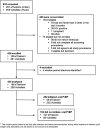Prospective study of oral pre-exposure prophylaxis initiation and adherence among young women in KwaZulu-Natal, South Africa
- PMID: 35785472
- PMCID: PMC9251857
- DOI: 10.1002/jia2.25957
Prospective study of oral pre-exposure prophylaxis initiation and adherence among young women in KwaZulu-Natal, South Africa
Abstract
Introduction: Oral tenofovir disoproxil fumarate/emtricitabine pre-exposure prophylaxis (PrEP), introduced into South Africa (SA) in 2016, has increasingly become part of HIV prevention standard of care. Given the urgent need for increased HIV prevention efforts for young women in SA, we conducted an implementation study to explore oral PrEP initiation and adherence, and the impact of oral PrEP on HIV incidence in this group.
Methods: This prospective cohort study (CAPRISA 082) was conducted at two sites (urban and rural) in KwaZulu-Natal, between March 2016 and February 2018. HIV-negative, sexually active women, aged 18-30 years, were enrolled and followed for approximately 10 months. Oral PrEP was offered as part of a comprehensive HIV prevention package. Adherence to oral PrEP was measured using pill counts and tenofovir-diphosphate (TFV-DP) levels. Characteristics of oral PrEP initiators versus non-initiators were compared using risk ratios. HIV incidence rates were measured using Poisson regression.
Results: Of 425 women enrolled, 262 (62%) initiated oral PrEP. Uptake was significantly higher at the rural site compared to the urban site (78% [n = 203/259] vs. 36% [n = 59/166], respectively, p-value<0.001). Approximately 25% and 50% had stopped using oral PrEP by 3 and 12 months post-initiation, respectively. Median pill count adherence was 90% (interquartile range: 81-97%); however, TFV-DP was only detected in 13% of samples tested, that is 56/431 samples from 97 (37%) participants who initiated oral PrEP. In total, 11 women seroconverted yielding an HIV incidence rate of 2.81 per 100 person-years (95% confidence interval: 1.40-5.03). Nine of 11 seroconverters had initiated oral PrEP; however, all showed drug levels equivalent to taking one to zero tablets per week. Among women who initiated oral PrEP, >50% had discontinued using oral PrEP by study end, with side effects, such as diarrhoea, nausea, headaches and rash, being the most frequent reason for discontinuation.
Conclusions: Despite moderate oral PrEP initiation and high pill count adherence, adherence as measured by TFV-DP levels was low and early discontinuation was high. The overall HIV incidence rate was high underscoring the critical need to address barriers to oral PrEP initiation, adherence and continued use, as well as expanding HIV prevention options for young women.
Keywords: HIV incidence; PrEP adherence; PrEP initiation; comprehensive HIV prevention package; implementation study; oral pre-exposure prophylaxis (PrEP).
© 2022 The Authors. Journal of the International AIDS Society published by John Wiley & Sons Ltd on behalf of the International AIDS Society.
Conflict of interest statement
All authors have no competing interests.
Figures
References
-
- UNAIDS . Country Fact Sheets: South Africa. 2019. https://www.unaids.org/en/regionscountries/countries/southafrica (accessed 08 March 2021).
-
- UNAIDS . Global HIV & AIDS statistics ‐ 2020 fact sheet. https://www.unaids.org/en/resources/fact‐sheet (accessed 08 March 2021).
-
- Avert . Women and girls, HIV and AIDS. 2020. https://www.avert.org/professionals/hiv‐social‐issues/key‐affected‐popul... (accessed 08 March 2021).
-
- Avert . HIV and AIDS in South Africa. 2020. https://www.avert.org/professionals/hiv‐around‐world/sub‐saharan‐africa/... (accessed 08 March 2021).
MeSH terms
Substances
LinkOut - more resources
Full Text Sources
Medical
Miscellaneous




